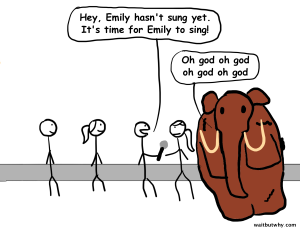Tonight is our first live choir rehearsal for 448 days. That’s extraordinary. I am very excited and very nervous. What if I’ve completely forgotten how to conduct?
I know some of my singers are nervous too, worrying that they have forgotten how to sing. Those of us who have sung during the pandemic have done so on our own. We have got out of the habit of adjusting to singers around us, and watching a conductor in real time. I’m going to put an emphasis on listening and looking tonight, staying responsive to what is happening around us, because the physical fact of being together with 30 people is going to feel very unusual.
I have no idea how the choir will sound. You cannot get a lovely blended sound when each voice is 2m away from their closest neighbours. Will the sound just fly away in the open air? I am going to try singing at a wall, so that we get some reverb back from it. It is always difficult, we have found, for each singing part to hear the others properly when we are performing outside. Now that will be even harder, since they will be spread so thinly and the two sides of the choir will be 9m away from each other. I’m going to amplify my voice, which I’ve never been comfortable with before, but I think it will help me to feel that I’m not shouting. I need to talk to the singers gently and support them as they take their first steps into singing together again.
I am prepared for the sound to be different – I think it’s going to be very moving and exciting just to hear the singers’ voices again after the Zoom-on-mute experience. I hope everyone will be able to relax and sing naturally – at least by the end of the session.
I attended a fantastic conference run by the Association of British Choral Directors a couple of weeks ago, talking about the emotional aspect of starting to sing together again. One of the speakers, Liz Garnett, talked about how our nervous systems behave when much-anticipated events happen. There is a rush of adrenaline and everyone is in a fight/flight mood. This is not just any choir rehearsal, this is an M&S… oh sorry, no, this is our First Rehearsal After Covid. It is much more like a performance than a practice, because we’ve all been longing for it for so long. There is great potential for people to be overwhelmed, and it’s helpful just to acknowledge this and be prepared for it. As the leader of the choir, I’ve decided not to sing our “Banging Greatest Hits” tonight but some gentler, more meditative songs to try to counteract all the excitement.
I have many new props for this rehearsal. My old simple kit list was music, music stand, register, tuning fork. The new list adds in keys for the walled garden, microphone and amplifier, mini PE cones, 2m measuring stick, clipboard, sanitiser, mask, spare mask, labelled copies of music for singers, and tissues. Because whatever happens tonight, I think it might be emotional.




